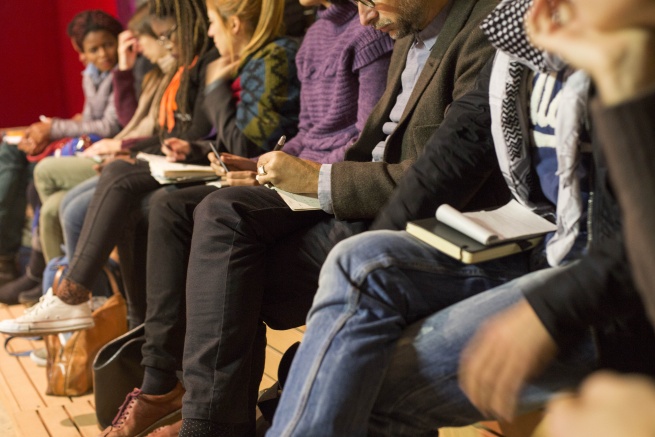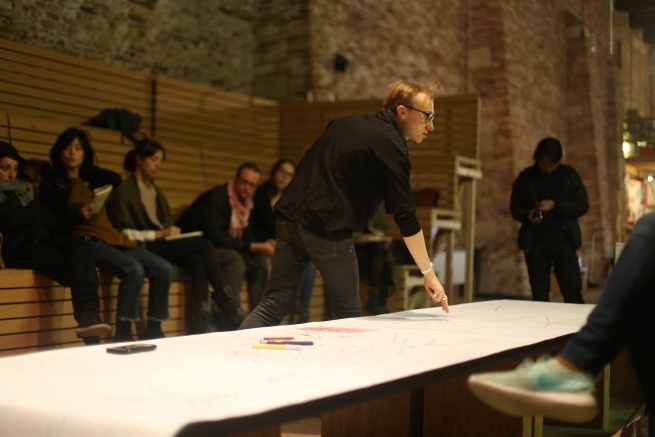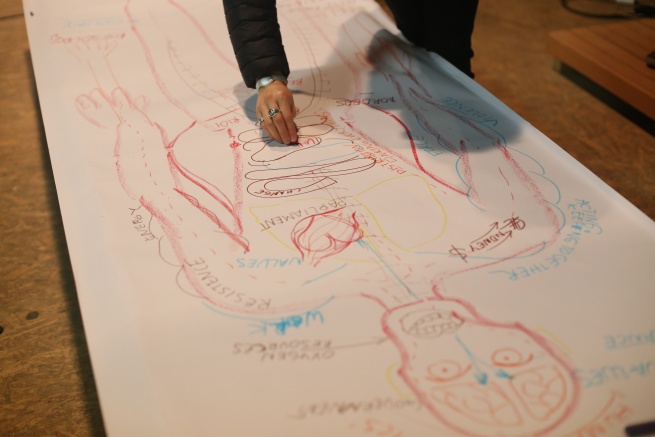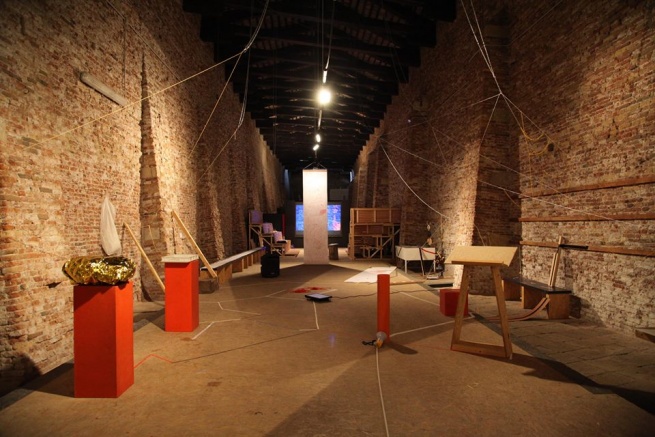Political crisis of today is dictated by outdated nation state model of mapping the world. While all the other systems already spilled over with economy, art, science going global, nation state still draws the lines on the geographical map.
Political power and it’s redistribution is the heart of the issue. Advancement of human civilization, apart of providing technological leaps, also demanded more transparency and visibility from power. It has always been ‘catch and run’ game - with new strategies of mystification of political power into institutional forms of different kinds. Authority redistribution mechanisms always tend to appear impersonal as their function is to communicate idea of being ‘detached’ from the matter of defining good and bad, right and wrong. Ethical, moral and aesthetic judgment seem to appear to naked eye as something defined and proved by centuries of common societal work, where standards of normal are the result of careful, almost Darwinist selection of what is better for all. The mythology of this process was first supported by the narratives of religious dogma and power, while today it’s mostly relies on fear and ignorance. Ulrich Beck[1] rightly highlighted one of the core characteristics of a modern life as the detachment from understanding of the basics of how this ultra-complicated world of ours works. Experts are supposed to decide what is good and bad, while comprehension of the verification mechanisms of their expertise is not an easy task for commoner. Expert networks include government, academia, economic and cultural elite, which are all intertwined through multiplicity of intersections within the hierarchies of confirmation of their expertise validity.

The Nationless Pavilion Laboratory, Nation 25 Under Construction, Sale Docks Venice 2015. Photo © Mohamed Keita
Epistemological processes of knowledge production and legitimization is strategically anything but transparent. The fundamental principle of the whole mega-structure is collective responsibility as silent conspiracy, bordering with plain nepotism. If I am demystified and going down, you are going down with me too, because the whole structure of validity behind our claims is constructed on mutual presumptions. The web of artificiality of social and political order demands almost religious belief in it’s realness. And if the certain structure is central to the multiplicity of these hierarchies, it’s guarded as a sacred cow by more than silence. It is supposed to actively reinforced by the actors in production of new ways to confirm the validity of ideological structure. It’s notoriously easier to imagine the end of the world, than end of capitalism not because of capitalism’s irreplaceability, but due to dependency on it’s rules and mapping of the roles and functions in socio-political matter overall majorities of the elites, contracted in unwritten and unsigned, but mutually understood by majority of them. When John Locke was speaking about social contract between state and citizens, he should have envisioned probably that not all the citizens sign the very same contract. All animals are equal, but realness, designed by the collective responsibility as silent conspiracy for value production and legitimization, proves that indeed some animals are more equal than the others.
The process of development of the Nationless Pavilion in the context of the 56th Venice Biennale ‘All the World’s Futures’ was launched in order to critically reflect on this complex subject. The chosen point of departure, the grounds of contemporary art, is strategic: because having the conversation about this at any other ground is by default ideologised and exists in opposition to dominating meta-narrative. The task of the curators seemed at the best impossible and at the worst plainly naive - can we envision possibility of alternative narrative of social construction beyond the known format the nation state?
The process of construction of the Pavilion was following the idea of artistic collaboration, beyond definitions and necessity to identify particular roles and functions. The hierarchies were flattened. Artists-moderators-workshop leaders-curators were engaged with participants, both political refugees and not, in the joint flow of critical reflection about the possible alternatives to the current order. However our task was not to oppose the contemporary forms. First of all, the task was to identify your own place in the modern totality. Different strategies were applied by the artists invited in the collaborative workshop processes.

The Nationless Pavilion Laboratory held by Emilio Fantin, in coll. with AtWork, Sale Docks Venice 2015. Photo © Mohamed Keita.
Emilio Fantin focused on the invisible process of construction of one’s identity. He attempted to trigger materialization of metaphysical experience on pre-cultural level: how can we arrive to possibility to imagine that the phrasing “(s)he is, I am, they are” can be read, for example, as “I are, they is, he are, we am”[2].
Ultra-Red related to the process of perception of space and time in the situation of crisis and stress. They focused on the social and psychological meaning behind the sounds of the spaces in Lecce and in Castri, where they worked with the growing community of those often forced into nomadism, refugees and migrants. The people whose experience of “exit” of the nation state in both physical and conceptual sense is apparent and recent were invited to share their experience of the new of the spaces sounds.
The ‘laboratory’ designed by me was devoted to the subject of possible political system that embodies in itself all necessary functions for providing functionality of social system, but deals away with the actual form of contemporary political ‘normality' - the nation state. I saw my task as contextualization of the discussion and brainstorming beyond the ideological meta-frame of ‘ever-lasting Present’ and push the process of group thinking into a free float.

The Nationless Pavilion Laboratory held by Denis Maksimov, Sale Docks Venice 2015, photo © Mohamed Keita.
I departed from where the concept of nation state originated - metaphor of Leviathan that was introduced by Thomas Hobbes in his seminal book bearing the same title. A state was described by him as a corporeal body, that is composed of the citizens as its cells. The organs of this meta-body are the functional elements of the political system and this anthropomorphic thinking about politics chained the discourse of political theory for the centuries to come. I engaged in a group conversation and brainstorming with the participants, where we discussed present theoretically, but still unimaginable in practical sense (beyond naivety) point: can we detach the form of politics in society from its function?
“You ask us to do the impossible” - reacted one of the participants - “For example, I wake up in the morning and look out of the window and see a landscape, sun, etc. And you tell us: imagine this is all un-existent, it’s only a form, and think about only its function”. I responded: “Yes, that is exactly what I am asking you to imagine. Imagine warmth without the sun, air without the clouds, smell of the fresh-cut grass without the grass itself”.

The Nationless Pavilion Laboratory heald by Denis Maksimov, image of the Leviathan, Sale Docks Venice 2015. Photo © Mohamed Keita
The first day was the hardest in this process: several times we seemingly got completely stuck, and several times the process of conversation needed to be ‘rebooted’ in order to step somewhere further. I used the aesthetic form of Dutch and Italian Renaissance period anatomical theatre (minus actual corpses): drawing the body and associating the functions of political system with its specific organs, representing their interconnections and interdependency. What was very important to reflect upon is that those interdependencies in many cases had nothing to do with the actual functions of the organ: the connections between them were justified exclusively by the aesthetic forms of representation. I was sure that we have to break through this barrier or representational thinking in order to go further: and it happened. After launching associative dialogue with form/function dichotomy in the center, participants actively engaged in the process of Artaud like cruelty theatre: deconstruction of the body and de-association of the formal structures to reconstruct a new one from functional value[3]. By the third day, we arrived to the visualization of the formless, openly-structured and geometric, but free from formalization and hierarchisation composition of functions, that was somehow natural and extra-terrestrial at the same time.
The processes of interconnection and communication between various functional ‘modules’ of this structure were named ‘osmosis’ by one of the participants. Another participant envisaged a possibility of detachment of the modules from the common structure when necessary. There was no necessity to think in the form of ‘skeleton’ or ‘spine’, no need for a central structure or (potentially) abusive leadership in a form of be-or-not-to-be integration. The result was pure form of organized, functionally structured chaos, which is addressing the challenges and needs at the moment of necessity. This system doesn’t try to survive for the sake of survival alone: it does not exist and clings to biological presence, but rather lives, breathes, changes, embraces curiosity and flexibility.
Hypostatization of subjectivity, introduced by post-structural thought, is the cornerstone for envisioning the world after the end of nation state. The participants of the art and theory laboratory “State-after-State: Future Potentiality of Post-Nation” were guided through the process of departing from the anthropomorphic analogy of the nation state. My approach was following the spirit of early school of critical theory, brilliantly contextualized by Walter Benjamin as ‘politicization of aesthetics’. The goal was not to develop or present certain alternative ideology to current narrative and trap ourselves in continuous loop of dialectical repetition with masters and slaves just changing their roles without reflecting and deconstructing the actual functional order.
There is no ambition to push forward via aestheticisation a certain form of political activism in the Nationless Pavilion, no pretense of presenting alternative ‘truth’. Even the good intentions of this form are dangerous, as the consequences of such process are beyond the control of initial intentions, as history showed us numerously. Our goal was and is to reveal the invisible in ways that will trigger critical thinking, shake the grounds of eternal form of nation state, geographical and political borders. We don’t want to re-draw the map - we want to imagine the life without those lines.
Refugees are invisible in the structures of nation state, they constantly exist in the limbo in-between space, not here (because they are undesired, problematic and not belonging to a “host”) and already not there (as they left there place of origin). Nomadism of other kinds is conceptually similar and the generation of globe-trotters of today’s 20-somethings feel this awkwardness of the socio-political “reality” which they inhabit, although find it complicated to contextualize the problem. It is clear why it is hard to grasp: the conversation of the systematic change is not taking place in any authoritative institutions, that possess power of legitimization of that “reality” we inhabit. Here enters contemporary art with all it’s institutionally perceived “awkwardness”: having no certain medium, agenda, standards and norms. It is a pure space of possible, where new[4] as Boris Groys brilliantly writes is not something that interprets the events of change on the grounds of historical understanding of it’s meaning, but is a “comrade of time”. New aka contemporary is something that going alongside with the currents of time. Nation state is obviously out of touch with the time we live in, and I am afraid it is so for quite long already.

The Nationless Pavilion, Nation 25 Under Construction, Installation view, Sale Docks, Venice 2015 © Nation25
Presentation in the context and in conversation with the nation state is paramountly important for the case of “what is to come after?” conversation having any impact on the discourse at all. This is the strategic reasoning behind the decision of Nation25 to be present in the form of Nationless Pavilion at the Venice Biennale. Arguably the most important institutional art event of the global magnitude, it claims to locate in the space of conversation “old” and “new”, and still is the best setting for discovering “possible” in manner of trans-disciplinary inquiry. The connection with the world through web of institutional contributors in the form of ministries of culture, galleries, collectors and private donors, artists and independent collectives provides a snapshot of “the state of the arts” as the medium of human activity. The natural mission of the Nationless Pavilion is to respond to the urgent crisis of socio-political reality by staging platforms for collaborative work and brainstorming between people of various backgrounds and origins, both visible and invisible in the context of contemporary definitions. The urge of pushing ourselves out of the comfort zone is necessary: the collapse of ‘the Present’ will be more catastrophic longer we postpone the change. Transdisciplinary platform of conceptual art has the potential to unite forward-thinking beyond the constraints of immediate practical application. Theory and research are fundamentally different - where the first one is asking the questions and the other one is suggesting hypotheses for designing potential problematics. Current time demonstrate growing cleavage between the two - how can you answer the questions that are staying within the limited contextual frame? This is exactly the problem of our ‘smupid’ (‘smart + stupid’, Douglas Coupland) times, when we are able to make high-definition pictures of Pluto surface and at the same time live in the socio-political institutional framework which was designed to host slavery, world wars and oppression.
I am happy to be part of the ambitious attempt to offer an alternative platform for thinking beyond this vicious deadlock of wanting to seem inescapable repetition.
NATIONLESS PAVILION // 15th International Architecture Biennale of Venice
During the 15th International Architecture Exhibition of Venice “Reporting From The Front”, The Nationless Pavilion has decided to work with the dynamics of individual and collective bodies in relation to the architecture of barriers, developing a series of performances under the name of Embodying Borders.
In “Border as method”, Sandro Mezzadra deals with the border as an epistemic system, a place of trans-disciplinary knowledge, the center of the production of knowledge itself. From an object –walled stable barbed-wired – of research, the border becomes the object of a perspective of change, from the instability of our contemporary world, something that must be crossed by states, global political players, governance agencies and capital.
In the same direction Embodying Borders looks at the borders as places to be suspended and reactivated: the “border as method” as the “body as method”.
These the first appointments of the cycle Embodying Borders that will be developed during the whole Biennale period:
-On Friday May 27 at Sale Docks, Venice, Nationless Pavilion will present "Embodying Borders, Primo Studio”, a first appointment of a performative cycle that will continue during the whole Biennale period, born from the collaboration between Nation25, the artistic collective Kinkaleri and the Palestinian dancer and choreographer Nadia Arouri.
A body, a space, a border. A relation of rethinking the reciprocal distances through the body and its presence, subverting the limit.
Embodying: to incorporate, from the lat. IN and CORPORE = mixing different elements and blending them together, but also to attract and convert to one’s own substance.
Embodying borders is the power of subverting and crossing the border, the resistance in living the divide, to be reduced but also to fill the emptiness in order to cross it, this all is at play. Not only “border as method” but “body as method”.
The “Primo Studio” (First Study) is the result of a period of artistic residency in Spazio K in Prato and is the prologue to a research path leading to the following Studies of the cycle “Embodying Borders”. Open to the public, it is a work in progress in Venice during the months of the Biennale.
-On Saturday, May 28 "Embodying Borders” will come to light in a site-specific, not pre-established, not traceable a priori manner, in the path of the Biennale Urbana, in collaboration with Stalker-Osservatorio Nomade.
Moreover in the context of the opening days of Biennale, Nation25 will participate at Sale Docks round table and presentation of the book "Spazi d'eccezione" (“Spaces of Exception”) (Milieu Edizioni).
Nation25 is included in the book with a new work, “Pangea”, an emerged land, the outcome of progress in the action “Square Tape” carried out with the Nationless Pavilion during the 56th Biennale Art Exhibition. Summing and reconfiguring the respective countries and Pavilions that granted our request for asylum, we created a new geography where Israel borders with Turkey, Brazil with Hungary, South Africa with Germany, to compose a unique land. Pangea is “the right of all men to live/visit: they join society by virtue of the right to common possession of the surface of the Earth”(from Immanuel Kant, Perpetual Peace).
The Nationless Pavilion was born for the desire of reactualize two concepts related to the exposition system of National Pavilions in the arts: the concept of Nation-State and the exhibitional methods. It has been found a pavilion for those who have left their country, because migrants and refugees, through the power of their bodies, they're finally putting a strain on nationalistic policies and the defense of their borders. Moreover, images and art works related to migration need to be told through direct experience, preferring laboratories, collective and common grounds, than the purely exhibitional solution, a form that could work on voyeurism and spectacularization on one side and detachment from reality on the other. The Nationless Pavilion tries not to use spaces for exhibitional purposes, but generative of relationships, and it works with local people in Venice and with people with a migratory background.
Human rights, the theme embodied by the migratory movement and subject who holds the destiny of our humanity, are also the subject to which dedicate wide research in arts, the only field that doesn’t respond to the logic and the superstructures of communication and information.
The Nationless Pavilion is a project conceived by Sara Alberani in 2014 and is part of the artistic platform Nation25 www.nation25.com/#!about3/cn7o
Nation25 refers to the 25th nation on Earth, an imaginative nation that really exists, constituted by 60 million individuals that have fled their country or are displaced from their homes due to war and racial and gender violence. It is an art platform that seeks to shine a light on the experience of migration, marginality and invisibility, and what they activate.
Founded in 2015 by Elena Abbiatici, Sara Alberani and Caterina Pecchioli and based in Rome, it intents to generate a dialogue between artists, curators, humanitarian, activists, both refugees and not. www.nation25.com
[1] Ulrich Beck, Risk Society: Towards a New Modernity, Sage Publications, New Delhi, 1992.
[2] Referring to the Nation25’s work Pangea published in Spaces of Exception, Milieu Edizioni, Milano, 2016.
[3] Cfr. M. De Marinis, La danza alla rovescia di Artaud, il Secondo Teatro della Crudeltà (1945-1948), I Quaderni del Battello Ebbro, Porretta Terme, 1999 and C.Pecchioli, Antonin Artaud, Segni e Disegni, Culture Teatrali, Ed. Carattere, Bologna, 2014.
[4] Boris Groys, On the New. Translated by G. M. Goshgarian, Verso Books, London, Brooklyn, 2014.










 Since 2011
Since 2011 

